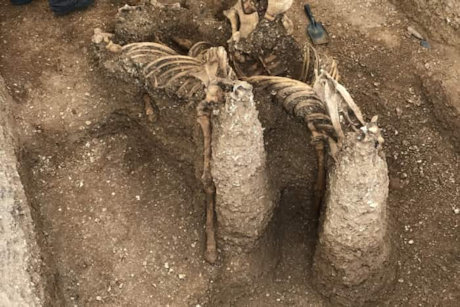|
The Iron Age Revealed – Pocklington’s latest spectacular finds described on TV.
 After months of waiting Pocklington’s worst kept secret was finally revealed when the BBC 4 ‘Digging for Britain’ archaeology programme was screened on BBC 4 on 19 December 2018. After months of waiting Pocklington’s worst kept secret was finally revealed when the BBC 4 ‘Digging for Britain’ archaeology programme was screened on BBC 4 on 19 December 2018.
Popular academic and TV presenter, Alice Roberts, introduced as special documentary, the ‘Iron Age Revealed’, as the fourth and final episode of the BBC’s 2018 ‘Digging for Britain’ series. Professor Roberts and her team set out to show that the Ancient Britons were not “a disorganized barbarian rabble” as portrayed by the Romans, who conquered Britain in the first century AD; but were in fact skilled, civilized and cultured. And the discoveries at Pocklington’s Persimmon Homes site were at the forefront of the argument.
It finally described in detail the find of another “unprecedented” Pocklington chariot burial, this time down The Mile. It was unexpectedly uncovered in the spring of 2018, but site security concerns, plus the BBC’s requirement for the news to be kept secret in advance of the programme, had meant a patient wait for the information to be made public.
The documentary started out by outlining how the Romans, who unlike their predecessors had written records, dubbed the Iron Age Britons headhunting, primitive, hard drinking, warlike and uncivilized. But that view is now being increasingly disproved and discredited thanks to Pocklington’s latest excavations.
In the BBC studios in London, Prof Roberts invited site director, Paula Ware, from MAP Archaeological Consultants, alongside archaeology lecturer and Iron Age expert, Melanie Giles, to discuss further the significance of the Pocklington finds. They started out looking at the initial Iron Age excavation at the David Wilson Homes site on Burnby Lane 2014-17 which included a notable and unusual discovery of a chariot, a vehicle described by Prof Roberts as: “the Iron Age equivalent of a sports car and a tank at the same time.” The studio discussion then moved on to The Mile investigations on the other side of town in 2018; which produced another chariot in advance of the Persimmon Homes development. The Mile burial consisted of a unique chariot, buried intact and upright alongside its horses, with some of its harness fittings. Inside its passenger compartment was laid the charioteer, on top of the remnants of an outstanding circular bronze shield, and with an impressive brooch used to fasten his cloak.
There was evidence that the burial was accompanied by a huge funerary feast that involved at least six young pigs. The feast remains included another Pocklington Iron Age ‘first’ – the spit meat hook used to roast one of the animals.
Paula Ware stated the Pocklington chariot is: “changing our outlook and perception of the Iron Age”, with Mel Giles describing it as: “one of the most exciting Iron Age discoveries ever found in Britain…the most spectacular burial I’ve seen”.
Prof Roberts also invited into the studio another Iron Age expert, Dr Peter Halkon, the Holme-on-Spalding Moor farmer’s son who became an archaeology lecturer and has studied and investigated Iron Age East Yorkshire for decades. Their discussion looked at chariots in more detail, and revealed that the Yorkshire Wolds was covered in well engineered chalk roadways in the Iron Age, another rebuttal of the established view that the Romans constructed Britain’s first road system. Peter drew on the findings of the aerial photography project from the summer to show evidence of the road network across the Wolds and its use by chariots like the one from The Mile.
 However, the TV programme did not feature a further notable grave found a few yards from the chariot burial. The further internment was of a young couple buried side by side, the man, aged 17-25, being identified a warrior who had been laid to rest on an oval shield and surrounded by iron and bone spear points. There is more information to come from the post excavation analysis, but the indications are that he met a violent end, with his death being due to traumatic injuries. However, the TV programme did not feature a further notable grave found a few yards from the chariot burial. The further internment was of a young couple buried side by side, the man, aged 17-25, being identified a warrior who had been laid to rest on an oval shield and surrounded by iron and bone spear points. There is more information to come from the post excavation analysis, but the indications are that he met a violent end, with his death being due to traumatic injuries.
Pocklington’s Mile chariot burial was the ‘Digging For Britain’ episode’s focal point for demonstrating the new line of academic thinking, Prof Roberts stating: “the truly spectacular grave sheds light on everything from our Iron Age ancestors’ engineering prowess, to their spiritual beliefs, to how they liked to stage a celebration, helping us tell a very different story about life in the Iron Age.”
MAP’s team of archaeologists uncovered considerable detailed evidence about the Pocklington charioteer to prove his status and wealth as an “important man, a leader or chieftain”. The experts revealed that he was both old and tall for his time – 5’ 8” tall and in his late 40s or maybe older. And they theorized that he had been a warrior in his younger days, and that the changes to his finger bone structure might indicate his experience in chariot driving.
And at the end of the programme, after the 2,000-year old remains had been screened and discussed, Paula Ware revealed what ‘Lord Pocklington’ actually looked like. The latest 3-D photography and computer aided design has produced an image of the Pocklington charioteer, a grizzled but imperious individual who exudes an avuncular calm authority and power. A remarkable insight into an unknown age, that thanks to recent archaeology from Pocklington is now becoming so much better understood.
Phil Gilbank, December 2018
|

